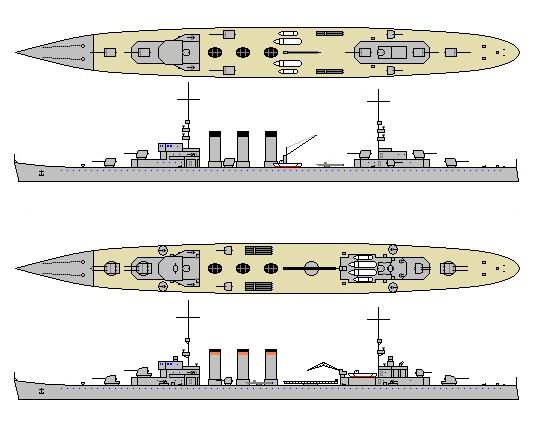Folks:
I'm contemplating the merits of retaining some Colombo class cruisers in service into the early '40s. The class was laid down between 1917 and 1919, and received a mid-life refit ten years afterward.
What I'm considering is rebuilding three into anti-aircraft cruisers, along the lines of historical British rebuilds of similar cruisers in WW2. They would be paired off with a battleship, having received the following modifications:
-The main armament and heavy AA would be replaced by four twin 12.5 cm DP deck mounts.
-Existing light AA would be supplemented by another ~8 to 10 35mm guns.
-The bow would be reshaped for improved seakeeping and to make her less wet.
-Machinery would be updated, with a target speed of 30 knots, and bunkerage improved modestly.
Think this would be a useful conversion? Or is the hull going to be too old/small/inefficient for such work to be economic?
Current stats are below...

Top: Columbo as built
Bottom: as refitted, 1927-1929
As Refitted, 1927-1929
Colombo, laid down 1917
Length, 152.4 m x Beam, 15.2 m x Depth, 4.6 m
5158 tonnes normal displacement (4561 tonnes standard)
Main battery: 6 x 15.0-cm (3x2 deck mount w/hoist)
Secondary battery: 4 x 10.5-cm (1x2, 2x1)
AA battery: 6 x 3.5-cm (6x1)
Light battery: 8 x 1.5-cm (2x4)
Weight of broadside: 349 kg
8 TT, 55.0 cm (2x4)
Main belt, 7.5 cm; ends unarmored
Armor deck, average 3.5 cm
Conning tower, 7.5 cm
Battery armor:
Main, 5.0 cm shields / secondary, 3.0 cm
AA, 2.0 cm shields / light guns, 2.0 cm shields
Maximum speed for 30006 shaft kw = 29.02 knots
Approximate cruising radius, 9000 nm / 12 knots
Typical complement: 304-396
Estimated cost, $3.205 million (£801,000)
Remarks:
Oil firing.
Relative extent of belt armor, 110 percent of 'typical' coverage.
Ship has slow, easy roll; a good, steady gun platform.
Main deck secondary guns subject to being washed down
in a seaway.
Distribution of weights:
Percent
normal
displacement:
Armament ......................... 96 tonnes = 2 pct
Armor, total ..................... 814 tonnes = 16 pct
Belt 366 tonnes = 7 pct
Deck 389 tonnes = 8 pct
C.T. 19 tonnes = 0 pct
Armament 40 tonnes = 1 pct
Machinery ........................ 1474 tonnes = 29 pct
Hull and fittings; equipment ..... 1934 tonnes = 38 pct
Fuel, ammunition, stores ......... 764 tonnes = 15 pct
Miscellaneous weights ............ 75 tonnes = 1 pct
-----
5158 tonnes = 100 pct
Estimated metacentric height, 0.8 m
Displacement summary:
Light ship: 4394 tonnes
Standard displacement: 4561 tonnes
Normal service: 5158 tonnes
Full load: 5615 tonnes
Loading submergence 1428 tonnes/metre
+++++++++++++++++++++++++
Estimated overall survivability and seakeeping ability:
Relative margin of stability: 1.27
Shellfire needed to sink: 2533 kg = 54.1 x 15.0-cm shells
(Approximates weight of penetrating
shell hits needed to sink ship,
not counting critical hits)
Torpedoes needed to sink: 1.1
(Approximates number of 'typical'
torpedo hits needed to sink ship)
Relative steadiness as gun platform, 72 percent
(50 percent is 'average')
Relative rocking effect from firing to beam, 0.16
Relative quality as a seaboat: 1.14
+++++++++++++++++++++++++
Hull form characteristics:
Block coefficient: 0.48
Sharpness coefficient: 0.32
Hull speed coefficient 'M' = 8.85
'Natural speed' for length = 22.4 knots
Power going to wave formation
at top speed: 54 percent
Estimated hull characteristics and strength:
Relative underwater volume absorbed by
magazines and engineering spaces: 109 percent
Relative accommodation and working space: 110 percent
Displacement factor: 112 percent
(Displacement relative to loading factors)
Relative cross-sectional hull strength: 0.99
(Structure weight per square
metre of hull surface: 385 kg)
Relative longitudinal hull strength: 1.12
(for 4.60 m average freeboard;
freeboard adjustment +0.56 m)
Relative composite hull strength: 1.01
+++++++++++++++++++++++++
[Machine-readable parameters: Spring Style v. 1.2.1]
499.87 x 49.86 x 15.09; 15.09 -- Dimensions
0.48 -- Block coefficient
1917 -- Year laid down
29.02 / 9000 / 12.00; Oil-fired turbine or equivalent -- Speed / radius / cruise
75 tons -- Miscellaneous weights
++++++++++
6 x 5.91; 0 -- Main battery; turrets
Central positioning of guns
Gun-shields
:
4 x 4.13; 0 -- Secondary battery; turrets
Main deck battery
:
6 x 1.38 -- Tertiary (QF/AA) battery
Gun-shields
:
8 x 0.59 -- Fourth (light) battery
8 / 0 / 21.65 -- TT / submerged / size
++++++++++
2.95 / 0.00 / 0.00 / 0.00; 110 -- Belt armor; relative extent
1.38 / 2.95 -- Deck / CT
1.97 / 1.18 / 0.79 / 0.79 -- Battery armor
(Note: For portability, values are stored in Anglo-American units)
+++++++++++++++++++++++++++++++++++++++++++++++++++++++


Quoted
The original springstyle tells me the secondaries are subject to being washed down in a seaway, but I'm not sure if the bow will change that or if it's more an average freeboard issue.Quoted
Originally posted by SwamphenQuoted
The original springstyle tells me the secondaries are subject to being washed down in a seaway, but I'm not sure if the bow will change that or if it's more an average freeboard issue.Quoted
Originally posted by RLBH